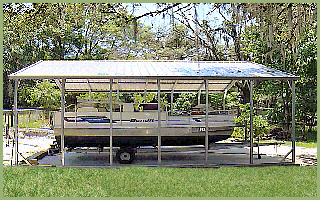Roof Side Panels Garages Carports Barns Metal Buildings
◊ Roof Side Panels
Here are some of the roof side
panels options we offer.
Roof Side Panels

Boat Port
A roof is the covering on the uppermost part of a building. A roof protects the building and its contents from the effects of weather and the invasion of animals. Structures that require roofs range from a letter box to a cathedral or stadium, dwellings being the most numerous.
In most countries a roof protects primarily against rain. In Persia the citizens used their roofs for milling wheat,farming,gardens and extra space. Depending upon the nature of the building, the roof may also protect against heat, sunlight, cold, snow and wind. Other types of structure, for example, a garden conservatory, might use roofing that protects against cold, wind and rain but admits light. A verandahmay be roofed with material that protects against sunlight but admits the other elements.
The characteristics of a roof are dependent upon the purpose of the building that it covers, the available roofing materials and the local traditions of construction and wider concepts of architectural design and practice and may also be governed by local or nationallegislation.
Contents |
Design elements
The elements in the design of a roof are:
- the material
- the construction
- the durability
The material of a roof may range from banana leaves, wheaten straw or seagrass to lamininated glass, copper (see: copper roofing),aluminium sheeting and precast concrete. In many parts of the world ceramic tiles have been the predominant roofing material for centuries.
The construction of a roof is determined by its method of support and how the underneath space is bridged and whether or not the roof ispitched. The pitch is the angle at which the roof rises from its lowest to highest point. Most US domestic architecture, except in very dry regions, has roofs that are sloped, or pitched. Although modern construction elements such as drainpipes remove the need for pitch, roofs are pitched for reasons of tradition and aesthetics. So, the pitch is partly dependent upon stylistic factors, and partially to do with practicalities. Some types of roofing, for example thatch, require a steep pitch in order to be waterproof and durable.[1] Other types of roofing, for example pantiles, are unstable on a steeply pitched roof but provide excellent weather protection at a relatively low angle. In regions where there is little rain, an almost flat roof with a slight run-off provides adequate protection against an occasional downpour. Drainpipes also remove the need for a sloping roof.
The durability of a roof is a matter of concern because the roof is often the least accessible part of a building for purposes of repair and renewal, while its damage or destruction can have serious effects.
